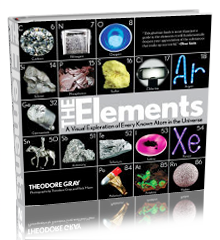Slice of Historical Sample. | |||
| Sample Image | QuickTimeVR Rotation | |||
| Slice of Historical Sample. We are very honored to have received a slice cut from one of the first batches of pure zirconium metal ever to have been isolated. Randall Fullman donated this sample, and has this story about it: "My grandfather, Martin Farlee, was an engineer who worked on the process to refine this metal at the US Bureau of Mines, Albany Research Center. Due to the flammable nature of the metal and the need for high purity for the nuclear industry, the process developed involved refining it in a vacuum using induction heating. I wished I could have gotten photos of the crucibles and induction equipment. In the same chamber in which it was refined, it was poured to make ingots for the tests. This sample is from these tests." "As an industrial metal, it is not traded as a precious metal such as gold, silver, platinum, etc. However about 30 years ago it was more valuable than platinum. " "The metal properties that are of interest are its high strength, and the fact that it is transparent to radiation. The main use for the metal is in fuel rods in nuclear reactors. It holds the fuel pellets while not interfering with the reaction by absorbing radiation." "Due to the use of the metal in the nuclear industries, the refining process came under the gun of the nuclear regulatory commission. Even though the metal is not radioactive, it is refined from sand from Australia. A survey of the tailings of the sand found a background radiation level very much like the level found in most red bricks used in buildings. As such it was declared low level radioactive waste, just the same as many old government buildings. This has created much grief for Wah Chang (a major refiner of zirconium), just as it has for many demolition companies trying to dispose of old bricks." On the subject of why he's willing to send us a piece of this sample, Randall reports: "Due to the shape of the sample, and the fact I had used it to pound nails in a pinch, taking a small slab off the bottom is not a problem. As promised, I got a sample cut for you after I found someone with a saw with liquid cooling." Analysis by x-ray fluorescence spectroscopy at the Center for Microanalysis of Materials, University of Illinois (partially supported by the U.S. Department of Energy under grant DEFG02-91-ER45439) showed no contamination within the detection limits of the machine, at worst about 100ppm. Zirconium usually occurs together with hafnium and the two are very hard to separate, so for this sample to have no hafnium whatsoever is remarkable, and indicates that they worked really hard to purify it. This in turn indicates that it was intended for nuclear applications where such purity is a necessity. Source: Randall Fullman Contributor: Randall Fullman Acquired: 26 June, 2002 Price: Donated Size: 3" Purity: >99.99% | |||
|

